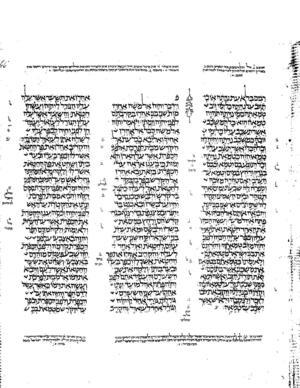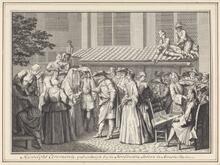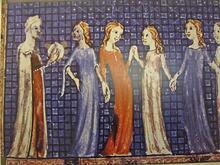Ba'alei Ha-Nefesh
Ba’alei Ha-Nefesh is a halakhic work written by Rabbi Abraham ben David (Rabad) of Posquieres, a Provençal rabbi, in 1180. It focuses on the laws of behavior during niddah (menstruation), and lays out Rabad’s theology of self-control, sexuality, and the role of Jewish women. The text defines a number of intentions that make sexuality holy and explores how men could keep their thoughts “pure.” Ba’alei Ha-Nefesh became one of the most important texts in the Jewish world concerning niddah and sexuality.
A The legal corpus of Jewish laws and observances as prescribed in the Torah and interpreted by rabbinic authorities, beginning with those of the Mishnah and Talmud.halakhic work composed in 1180 that deals with the laws of behavior during menstruation (Menstruation; the menstruant woman; ritual status of the menstruant woman.niddah), Ba’alei ha-Nefesh (Masters of the Soul) was written by Rabbi Abraham ben David of Posquières (the Rabad, c. 1125–1198), who was also known as ba’al ha-hassagot (critic par excellence). The book has seven “gates”: Abstinence, Amelioration of Discharges, Stains, Counting and Inspection, Immersion, Water, and Holiness. The book deals mainly with the laws of niddah, both in the introduction and at the end of the book, entitled “The Gates of Holiness,” (Sha’arei Kedushah) where the author expands on the nature of women and sexuality.
This article will explain the Rabad’s theoretical position on the laws of ritual purity as reflected in the introduction and conclusion of the work, the title of which reflects the importance of controlling the nefesh, or soul, the organizing principle of the whole book. The author writes: “I have called the book Ba’alei ha-Nefesh because there is a law for those who control their souls rather than their souls controlling them,” and “Because of this, the zaddikim (the righteous) were called ba’alei ha-nefesh because they are the masters of their souls and the lords of their desires” (p. 13).
The Role of Women
In the introduction, the author develops the view that the purpose of the entire world of creation is to fulfill human beings’ desires and to serve humankind. This creation puts at the service of humankind both lower creatures, such as animals and insects and higher creatures, such as the sun, moon, and constellations. All these are ordered to serve mankind.
In this view, the creation of woman is also seen as serving man. The Rabad derives this from details of the Creation account, which assumes differences between the creation of female animals and that of female human beings:
… They were created as male and female from the earth. When the rest of the creatures were created, woman was with man just as the female animal is with the male: she does not accept the male’s control nor remain near him to serve him. … Therefore, the Creator discerned mankind’s needs and pleasures, and created him unique and alone. He took one of his ribs and fashioned woman from it, and brought her to the man to be his wife and helpmate and support him, since she is considered one of his limbs, which was created to serve him, and that man should have control over her just as he has control over his limbs. …
On this basis, then, the laws of niddah teach human beings how to treat one of the limbs of their bodies so that it may serve and benefit them appropriately. In Hebrew, the work’s original language, the root ??? (shamesh) has double significance. The first is connected with work that one person does for another, serving another human being, as in the Talmudic expression on serving the sages (Avot 6:6 and Suspected adulteressSotah 22a, inter alia), but the word tashmish denotes sexual relations. Thus the author makes a connection between the creation account and his understanding of women’s status in relation to men, and writes of sexual relations as an activity in which the woman serves the man.
But the creation account, as a story that establishes woman’s status in relation to man, also points out man’s duties toward woman, whom he promises to cherish as one of his own limbs. Hence the Rabad (p. 124) derives a relatively wider perception of the A biblical or rabbinic commandment; also, a good deed.mitzvah of Biblically mandated fulfillment of a wife's sexual needs.onah (lit. a period; the time when the husband is obliged to satisfy his wife’s sexual needs). According to the view of woman as a limb of her husband, he is required to provide for all his wife’s needs. The author pays special attention to the man’s duty to have sexual relations with his wife: “If he sees that she seeks to be intimate with him, that she is conciliatory with him and ornaments herself before him, then he must gladden her by fulfilling the mitzvah. …”
Rabad bases his statements inter alia on those of the sages in BT A seven-day festival to commemorate the Exodus from Egypt (eight days outside Israel) beginning on the 15th day of the Hebrew month of Nissan. Also called the "Festival of Mazzot"; the "Festival of Spring"; Pesah.Pesachim 72b and The widow of a childless man whose brother (yavam or levir) is obligated to marry her to perpetuate the brother's name (Deut. 25:5Yevamot 62b, but along with the emphasis on the husband’s duty to satisfy his wife, he warns against overindulgence. “Let him not get her too used to having all her desires fulfilled, but scold her once or twice lest her yoke overburden him. His scolding will also keep her from taking control over him, since there is no evil greater than a woman who controls her husband” (p. 123).
Intention and Motive for Sexuality
The importance of the motives for sexual activity is one of the work’s most interesting discussions. The author shares an emphasis on the intention and motive behind the act of intimacy with the author of Iggeret Ha-Kodesh, who also places the issue of intention at the center of his works.
It is interesting to compare these two compositions with contemporary Christian works which also refer to intention and motive as part of their discussion and which in certain instances present a more lenient and permissive view of sexual relations within Christianity.
In the last part of his work, the author includes four different intentions that can accompany the sexual act and which determine the level of purity of the union between husband and wife. Regarding the deciding nature of the intentions, the author says: “And now, we must understand what is proper thought during the act and what is improper thought, which corrupts it.”
The first intention is to fulfill the commandment of procreation. The second is the intention to beget a child. The third is the commandment to provide for the sexual needs of one’s wife (onah), and the fourth is to satisfy his needs through her, using her as a means to avoid forbidden lusts.
The Rabad claims that the first three intentions “merit most of the reward,” while the fourth merits “a reward less than that of the [other] three.” This is because the husband could keep himself from sin in another way, by elevating his thoughts: he might think of man’s insignificance in the world or of catastrophes that occur.
Later, it becomes apparent how central the principle of intention is to the Rabad’s thought. He is also exacting about the last principle, stating that only the intention to be saved from sin is what earns the reward and if the man had the intention of satisfying his lust, he is closer to incurring a loss.
Sanctity of Thought
The beginning of Sha’arei Kedushah also emphasizes the principle of intention. There, the writer connects two different kinds of holiness, one related to the physical sense of touch and the other not—the familiar distinction between thought and action. The author finds such a doubling in the verse “You shall sanctify yourselves and be holy” (Leviticus 11:44). The double mention of holiness hints at two different kinds of sanctity: that of the body, which is mostly connected with touch and the sense of feeling, and that of thought and intention which, as we have seen, is central to the Rabad’s view:
Just as a man needs to refrain from physical sins, so he must also refrain from any thought of them in his heart. If such a thought occurs to him, he must force himself to remove it from his heart and must certainly have no intention of completing the thought, since a completed thought leads to action and is therefore considered as comparable to an act. Of this it is said: Thus I will hold the House of Israel accountable for its thoughts (Ezekiel 14:5), and this is the second kind of sanctity Scripture warns us about, saying, “Sanctify yourselves”—in deed, and “Be holy”—in thought. … Just as I [God] am holy in action and thought, so must you become holy, thus you have learned that one is not called holy until one has sanctified one’s actions and thoughts. (112–113)
Abstinence in thought—that is, from evil intentions—is no less important than keeping oneself from the actual sin. This involves great effort in the war against evil intentions, in which one must “force it out of his heart” and “not complete it.” Here, thought takes on the character of action, while thoughts of sin become sin itself.
For the Rabad, sanctity of the mind and heart is so important that he dedicates the work’s last part to it. Apparently the writer wishes to create a balance between the central part of the work, which deals with precise details of the laws of niddah, and the last part, which deals with the secret of pure intentions.
In this part, I would like to write at length since there is benefit in doing so, and it is a matter in which most people fall short. (112)
Purification of thought is also the principle that guides the Rabad to interpret favorably the Sages’ accounts of scholars’ sexual behavior with their wives (119–122). He interprets this, according to his mystical system, as behavior intended to thwart the possibility of impure thoughts arising during intercourse. The behavior of the sages is not a matter for modesty, as it perhaps at first appears, but an effort to prevent extraneous thoughts from intruding during intimacy. Ima Shalom’s account of her husband, who is intimate with her only at midnight, who uncovers one handbreadth while covering another, and who seems like one compelled by a demon (BT Nedarim 20b), is perceived not only as an example of modest behavior but as behavior meant to prevent extraneous thoughts: “He would perform the act in awe, like one terrified by a demon, so that no foreign thought would disturb him. Even though there is concern for modesty here, such were his intentions” (120).
Later, the Rabad’s opinion on sexual matters moves from many warnings against yearning for bodily pleasure to satisfying one’s needs according to The legal corpus of Jewish laws and observances as prescribed in the Torah and interpreted by rabbinic authorities, beginning with those of the Mishnah and Talmud.halakhah. This is seen as a difficult and complicated mission: “Therefore, we need to distinguish between what is permitted and what is forbidden, and between receiving reward and paying for transgression.”
The writer is aware of his complicated message, so he also proposes a strategy of balance, often using the phrase “The left hand pushes away while the right hand draws near” to illustrate the balanced behavior he suggests, by which a person should satisfy his desires yet avoid overindulgence while doing so.
One cannot attain wisdom in Torah she-bi-khetav: Lit. "the written Torah." The Bible; the Pentateuch; Tanakh (the Pentateuch, Prophets and Hagiographia)Torah except through joy, so a person should not avoid any joy connected with a mitzvah or any enjoyment connected with a mitzvah, though he should be alert to his impulses and careful lest he fulfill his lusts.
Important of Ba’alei Ha-Nefesh
We should bear in mind that because of the Rabad’s high status in the Middle Ages, this book was one of the most popular works on the laws of niddah. It is quoted in the works of the Lit. "additions." Collections of comments made by Rashi's students and descendants who undertook to expand, elaborate and develop Rashi's commentary on the Talmud.Tosafot, the Ramban (Rabbi Moses ben Nahman, 1194–1270), the Rashba (Rabbi Solomon ben Abraham Adret, c. 1235–c. 1310), the Haggahot Maimuniyyot (commentary to Maimonides’ Yad Hazakah by Meir ha-Priests; descendants of Aaron, brother of Moses, who were given the right and obligation to perform the Temple services.Kohen, end of thirteenth century) and the Beit Yosef (Rabbi Joseph ben Ephraim Caro, 1488–1575), who quoted his works extensively. The ethical and general guidance contained in the last portion of the book, “Gates of Holiness,” led to its being reproduced many times.
Abraham ben David, Ba’alei ha-Nefesh. Jerusalem: 1988.
Biale, David. Eros and the Jews. New York: Basic Books, 1992.
Cohen, J. “Rationales for Conjugal Sex in Rabad’s Ba’alei ha-Nefesh.” Jewish History 6 (1992), 65–78.
Feldman, David. Marital Relations, Birth Control, and Abortion in Jewish Law. New York: New York University Press, 1968.
Grossman, Abraham. Piety and Rebellion: Jewish Women in Europe in the Middle Ages, trans. (English) by Jonathan Chipman. Waltham, MA: Brandeis University Press, 2004.






